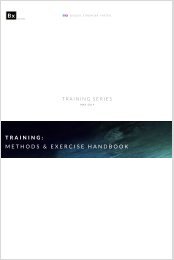Create successful ePaper yourself
Turn your PDF publications into a flip-book with our unique Google optimized e-Paper software.
HTKSPORT<br />
Viscoelasticity is the way in which the internal tissues of our body create movement.<br />
In liquids, the same property is measured in viscosity (thickness) – for example honey<br />
is more viscous than water because it resists deformation more. Viscoelasticity acts as<br />
a ‘damper’ (i.e. such as would be placed on a stiff car spring to modify the rate of<br />
elastic return). It is a time-dependent way of regulating elastic ‘spring-back’. The<br />
internal tissues of the human body rely on this to change from one movement to<br />
another.<br />
If biotensegrity is the basis of the architecture of our collagen matrix, then it also has<br />
elastic integrity when we are still. We do not deflate. The body benefits from the value<br />
of elasticity just as much when sitting as when running; peak performance and peak<br />
‘pre-formance’ are both animated by the same system.<br />
Without a doubt, there is a wealth of knowledge in this area, far beyond the basics<br />
presented in this book, in the work of Müller and Schleip; particularly the book Fascia<br />
in Sport and Movement. I encourage all readers to explore their work. This manual will<br />
attempt to sum some of the overarching principles, but for far greater depth please<br />
explore their work in this area.<br />
1.2 Utilising Force Optimally<br />
Applying the tensegrity model of architectural structures to the human body<br />
demonstrates that when forces are introduced at one point in a structure, they are<br />
simultaneously transmitted to other parts of the same structure. During almost all<br />
movement patterns, it's not just the immediate muscles that are involved; rather, a<br />
wide network of different muscles will contribute and share in the force production,<br />
and most importantly – force absorption (see more below).<br />
The speed at which the athlete moves is determined by how much of the force<br />
generated by the movement of the body – predominantly kinetic energy – is utilised<br />
to explosively propel them forward. Part of that is contributed by biomechanics and<br />
movement technique. However, the majority is determined by the elasticity and<br />
engagement of the body’s fascia network, and its ability to transmit and transfer force<br />
efficiently.<br />
05<br />
JUNE 2018 | ISSUE 01




